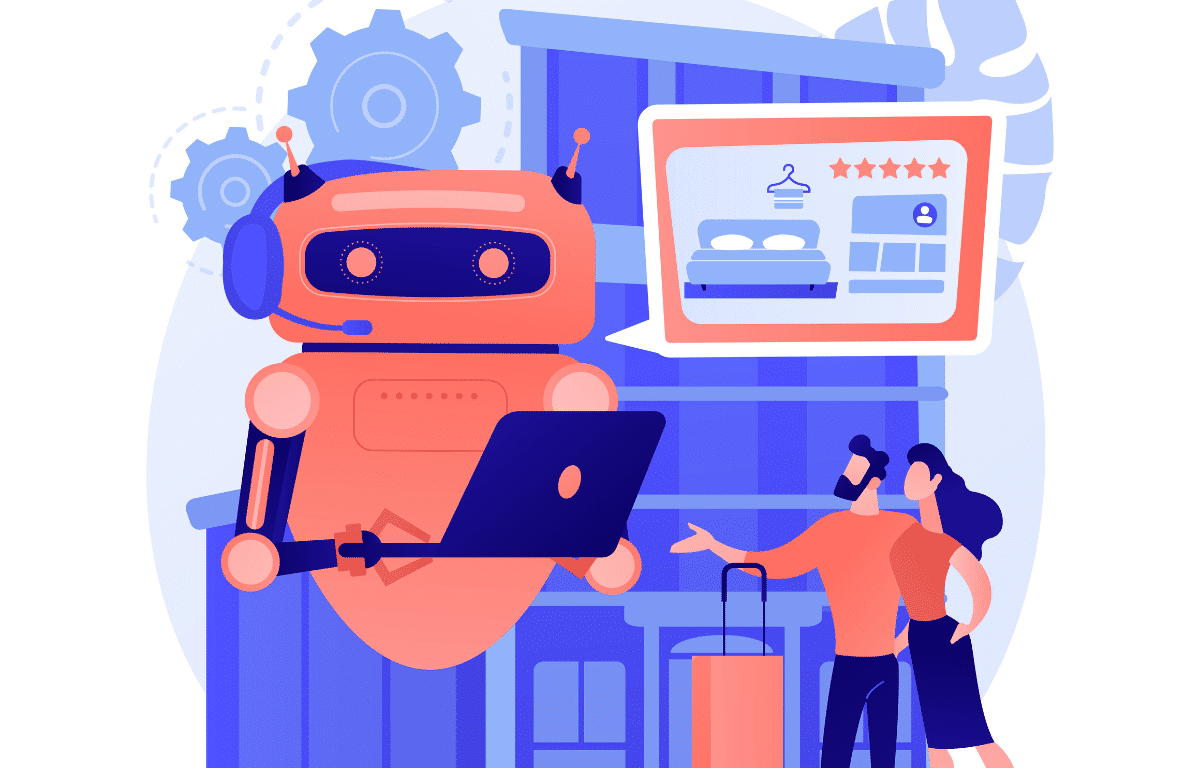9 Practical Ways to Use AI for Your eCommerce Business

In the present eCommerce landscape, businesses face both exciting opportunities and formidable challenges. As technology continues to push the boundaries of what is possible, one innovation stands out as a game-changer – Artificial Intelligence (AI).
AI has transformed the way businesses, including eCommerce companies, can operate and connect with customers. Thanks to its ability to analyze vast amounts of data, make intelligent decisions, and adapt in real-time.
This article goes into detail about the practical use cases of AI in eCommerce. It doesn’t matter where you’re just starting out or have an established eCommerce business online. You’ll discover how to leverage this transformative technology for propelling your business to new heights.
How to Use AI in eCommerce
Below are the best ways you can use artificial intelligence and its tools for your eCommerce business.
-
Copywriting
eCommerce involves a lot of copywriting as you try to convert your audience into customers. But writing copy can be a daunting task. That’s where AI copyrighting tools come to your aid.
Check how AI can boost your copywriting efforts:
- Product description writing: Sometimes, you may lack the right words to describe a product. AI can help you write descriptions using persuasive language that compels users to make a purchase.
- Social media copywriting: AI can craft social media posts by using a social media post generator, which can be optimized for various platforms, taking into account character limits, hashtags, and engagement trends to increase the reach and impact of your social media presence.
- Email marketing campaigns: AI can help compose subject lines and email body content that capture recipients’ attention and increase open and click-through rates.
A variety of copywriting tools that use AI exist nowadays. Some examples are Jasper, CopyAI, and Writesonic. Now, all you have to do is fill out details like the product name and a short description. These tools can come up with the entire copy using popular formulas and frameworks like BAB (Before-After-Bridge) and AIDA (Attention-Interest-Desire-Action).
-
Blog Writing
If you have an eCommerce website with a blog section, you’re aware of how blogging can bring in significant extra traffic. You can then direct this additional traffic to your product pages. Using AI in blog writing can significantly streamline the content creation process and enhance the overall quality and efficiency of your blog.
Here are some ways you can use AI in blog writing:
- Content research: AI can quickly gather data from various sources, including articles, research papers, and websites. Such valuable information and statistics can support your blog’s arguments and claims.
- Topic generation: AI-powered tools can analyze trending topics, search queries, and social media discussions to suggest relevant and engaging blog topics. These insights help you identify popular subjects that resonate with your target audience.
- Content outline and structure: AI can assist in creating blog outlines by organizing key points and structuring the content logically. It helps ensure that your blog has a cohesive flow, making it easier for readers to follow.
- Grammar and spell checking: AI-powered grammar and spell-checking tools can help improve the overall quality of your blog by catching errors and suggesting corrections in real time.
- Sentence rewriting: AI tools like paraphrasing generators can rephrase sentences to make them more unique while retaining the original context. This helps avoid duplicate content and enhances the blog’s SEO.
Now, what you’ll need is a suitable AI blog writing tool for this purpose. Most AI writing tools can write both copy and blog articles. Feel free to refer to the examples given in the previous section on AI for copywriting.
-
Search Engine Optimization (SEO)

Did you know that you no longer need to worry about spending a lot of time to tweak your content for ranking on Google? AI can analyze all the top pages on search results and provide you with ways to optimize your posts. Below are some areas of SEO that AI can help:- Keyword research: AI-powered tools can analyze search trends and user behavior to identify relevant keywords with high search volumes and low competition. This helps in optimizing website content for keywords that have the best chance of ranking well in search engine results.
- Content optimization: You can also use AI to review your existing content and suggest improvements for improving its relevance, readability, and SEO-friendliness. AI tools can suggest proper keyword placement, content length, and readability scores.
- Writing titles and meta-descriptions: Titles and meta-descriptions are what people see on search engine result pages before deciding whether to click on a result. AI writers can craft compelling titles and meta descriptions with relevant keywords in them.
A few examples of intelligent tools for SEO that you can use are Surfer SEO tool, MarketMuse, and Clearscope. What happens is that you just input your previously written content and the tool analyzes it to provide recommendations for SEO improvement.
-
Image Generation
AI is also helpful in image generation for eCommerce tools. It enables businesses to create high-quality, visually appealing product images and marketing materials with remarkable efficiency and creativity.
Let’s look at some ways AI works for generating images:
- Automated background removal: AI can automatically remove backgrounds from product images. This allows your business to display products on a clean, consistent background or even create transparent product images for versatile use in marketing materials. A great example of this is an online background removing tool, which allows you to remove background from image files effortlessly using AI technology.
- Image enhancement: AI-powered image processing algorithms can enhance product images by adjusting lighting, colors, generating AI comic books and contrast, resulting in more attractive and professional-looking visuals.
- Image upscaling: AI algorithms can also upscale low-resolution product images without significant loss of quality. No more showcasing products in poor resolution on various platforms.
You could also use AI image generators to create high-quality and original visuals for your promotions. You can use AI-generated images in your emails, social media posts, website, and more.
-
Video Content Creation
Creating videos can consume a lot of time. As an eCommerce business, some videos you may be involved in creating are marketing videos and explainer videos. AI tools can help in the following:
- Automated video editing: AI-powered video editing tools, such as Video Summarizers, can automatically compile clips and edit footage to create ready-to-use videos.
- Voiceover for videos: Voice generators use AI to provide natural-sounding voiceover and narrations. They eliminate the need for hiring voice actors and offering flexibility in multiple languages and accents.
- Talking heads and virtual presenters: AI-generated talking heads and virtual presenters can deliver product demonstrations, tutorials, and marketing messages.
- Video transcription and subtitling: AI can automatically transcribe video content and generate subtitles using advanced algorithms. This makes videos more accessible to a broader audience, including those with hearing impairments or language barriers. And if you prefer to do voiceovers for your videos, you can rely on an MP3 to text converter so your audio content can be transcribed efficiently, further enhancing accessibility and aiding in video search engine optimization efforts.
- AI-powered video creation: With an AI video generator, the creation of professional marketing and explainer videos becomes effortless, delivering polished, brand-aligned content in record time.
-
Chatbots

AI has also significantly transformed the capabilities of chatbots and improved automated customer service and user experiences. With advanced AI algorithms and natural language processing (NLP) capabilities, chatbots have evolved into sophisticated virtual assistants that can offer personalized, real-time support to online shoppers.First of all, AI chatbots can interpret complex questions and provide relevant answers. Interacting with an AI chatbot would be just like chatting with an actual human.
What’s more, AI-powered chatbots can provide round-the-clock customer support, address inquiries, and resolve issues at any time. This constant availability ensures that customers receive prompt assistance and boosts overall satisfaction and loyalty.
As if that’s not enough, AI allows chatbots to analyze customer data, including past purchases, browsing behavior, and preferences. This data-driven approach enables chatbots to offer personalized product recommendations and tailor interactions to individual customers. This enhances the engagement and conversion rates.
-
Email Assistant
Now AI as an email assistant just works like the case of chatbots. But in this case, you leverage AI in managing all messages you get via your email. It won’t just be about responding to questions about your products.
Here’s how these virtual assistants can help you manage your emails more efficiently and improve productivity:
- Email responses: You can set up an AI tool to automatically reply to the emails you receive. This is among the most popular uses of an AI email assistant tool.
- Draft composing: These tools can suggest responses to common emails based on the user’s writing style and past interactions, saving time in crafting replies.
- Automated inbox management: These assistants can categorize emails, prioritize messages, and sort them into relevant folders, ensuring that users see the most important emails first.
- Email summarization: AI can summarize lengthy emails to provide you with concise overviews. This helps you to quickly understand the content without reading the entire message.
On top of it all, specific AI tools can even analyze your emails and calendars to propose meeting times and schedule appointments. It’s a great way to simplify the process of arranging meetings.
-
Translation
AI can significantly enhance the translation of eCommerce product posts and pages. This offers businesses the ability to reach a global audience and expand their market reach effectively.
Advanced AI algorithms can grasp the context of the source text and ensure that the translated content is accurate and relevant. There won’t be misinterpretations and misunderstandings.
Another benefit is that AI-powered machine translation can rapidly translate large volumes of text. You’re able to localize their content quickly and efficiently.
Additionally, AI-driven translation tools can provide real-time translation for dynamic eCommerce pages, such as product listings, customer reviews, and live chat support.
-
Sentiment Analysis
AI-powered sentiment analysis has become a game-changer for eCommerce businesses. It enables you to gain valuable insights into customer opinions, emotions, and preferences expressed in online reviews, social media, and other user-generated content.
AI can analyze vast amounts of text data to determine the sentiment behind customer opinions. This helps you understand how customers feel about your products, services, and brand.
These sentiment analysis tools provide real-time feedback. What this means is that you’re able to respond promptly to positive feedback and address negative sentiments or issues raised by customers.
Conclusion
Embracing AI in eCommerce is no longer a distant possibility; it has become a practical necessity for businesses seeking to thrive in the digital age. The diverse applications of AI present unparalleled opportunities for growth and success. These applications range from writing assistants and chatbots for customer support to content creation and sentiment analysis.
If you leverage AI-driven solutions, your eCommerce businesses can unlock new levels of efficiency. You get a chance to cater to your customers’ unique preferences and optimize your operations in ways that were previously unimaginable.



